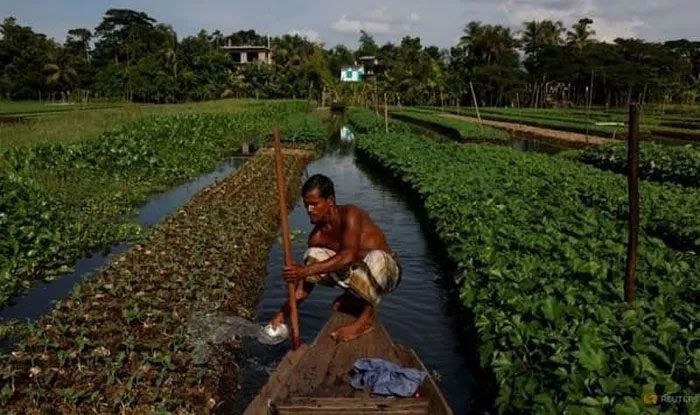Farmer Mohammad Mostafa, living in southwestern Bangladesh, has revived the ancestral practice of floating farming in the face of rising sea levels and flooding that threaten arable land.
Prolonged flooding is an increasing threat in southwestern Bangladesh, prompting self-sufficient families to turn to floating rafts for growing vegetables and fruits such as cucumbers, radishes, bitter melons, papayas, and tomatoes. These farming rafts, woven from water hyacinth, provide them with a viable farming method during the increasingly harsh monsoon season, as the land is no longer dry as it once was.
This 200-year-old method was originally used by farmers during the local flood season, which typically lasts about five months each year. However, nowadays, the area is submerged for 8 to 10 months, with the inundated land area increasing.
“Now, the land is flooded for longer periods. This ancient technique helps us make a living; my father and ancestors farmed this way. Previously, I tried to earn money by selling fruit but ended up in debt. I tried my luck with floating farming five years ago, and it has brought a significant change to my life,” shared farmer Mostafa, who is the sole breadwinner for his family of six.
Currently, there are 6,000 farmers in southwestern Bangladesh practicing floating farming. Pirojpur district in the Barisal region has 157 hectares of floating rafts, while Nazirpur district has 120 hectares.
Digbijoy Hazra, an agricultural official in Pirojpur, stated: “Floating farming requires less space than conventional farming and does not need pesticides. As we combat the impacts of global warming, floating farming may indeed be the future.”

Floating farming model in Pirojpur district – (Photo: Reuters).
According to the Global Climate Risk Index 2021 by the non-profit organization Germanwatch, from 2000 to 2019, Bangladesh ranked seventh among the countries most heavily affected by climate change.
Last year, the Asian Development Bank (ADB) also assessed: “As the world’s largest river delta, much of Bangladesh regularly faces flooding—especially flash floods—along with erosion.” More than a quarter of the country’s 165 million population lives in coastal areas.
A report from the International Monetary Fund (IMF) in 2019 identified that rising sea levels and erosion could cause Bangladesh to lose 17% of its land area and 30% of its food production by 2050.
Farmer Mostafa mentioned that with floating farming, he is currently able to sustain his family. However, profits have also shrunk due to rising costs recently. This year, he had to spend about 4,500 taka (43 USD) for 1.2 tons of water hyacinth to make a new raft—last year, he only spent 1,000 taka (nearly 10 USD).
It takes two months to weave a farming raft, which is typically 6 meters long and 1 meter wide, and lasts for 3 to 4 months.
Farmer Mohammad Ibrahim feels more secure practicing floating farming, as it also allows for a greater variety of vegetables and fruits to be grown. He shared: “The water level is rising. The place where I used to play football is now submerged every time the tide comes in.”
However, floating farming also has its drawbacks. Mrs. Murshida Begum, Ibrahim’s wife, has to spend 8 hours each day preparing seedlings to plant on the raft, and the water hyacinth causes itching and sores all over her hands.



















































